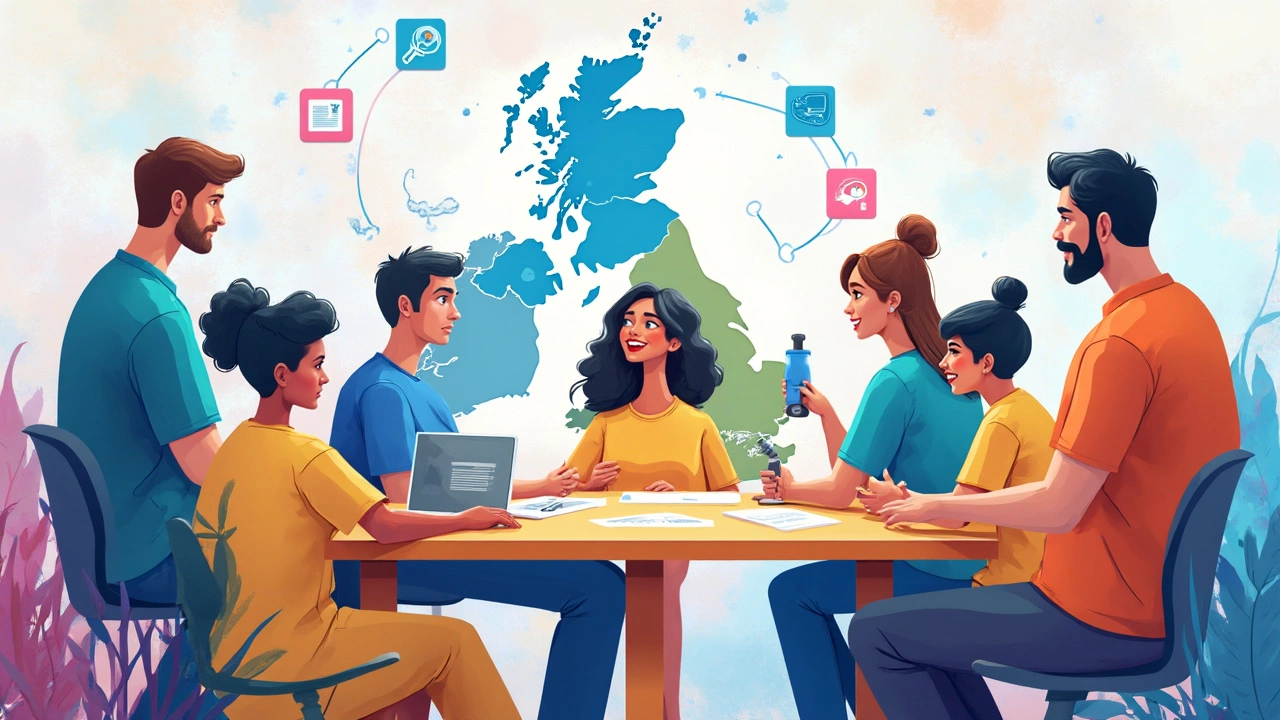When we think about online students, many of us might jump to an image of a college kid in pajamas attending virtual lectures. But here's a fun fact: the average age of online students in many programs is closer to 32! Surprised? You’re not alone. The world of online learning is breaking stereotypes, attracting people from all walks of life, and not just the tech-savvy younger crowd.
Why are older students flocking to online education? Flexible schedules, for one. Whether you're juggling a day job, family commitments, or just want to keep your evenings free, learning online offers a way to upgrade your skills without putting your life on hold. Take Janice, a 45-year-old marketing manager who pivoted towards digital marketing. With family obligations, she needed schooling that fit around her busy days, not vice-versa.
From stay-at-home parents ramping up skills for a career comeback, to mid-career professionals branching out into new territories, online courses are designed with a wide audience in mind. They offer a lifeline to those who might have felt left out of traditional education due to age or life's unexpected turns.
- Breaking Stereotypes: Who's Really Studying Online?
- Why Age Matters in Online Education
- Adapting Online Courses for Different Stages of Life
- Future Trends in Online Learning Demographics
Breaking Stereotypes: Who's Really Studying Online?
Online education has definitely shattered some old-school stereotypes about who can be a student. Gone are the days when college was just for the teens fresh out of high school. Statistics from recent years show that a significant portion of online students are actually in their late 20s to mid-30s, and more than 15% are over 40!
So, who are these learners? Well, for starters, many are working professionals aiming for career advancements. Online platforms are a hit among those who want to skill up without quitting their jobs or moving cities. Imagine a software developer in her 30s learning data science on the side. That's real and super common.
Then you've got the career-changers. Think of a mid-level manager who's seen the future and decides it involves coding. Online courses let them shift gears smoothly. Also, don't forget the stay-at-home parents gearing up to re-enter the job market or gain new skills while balancing family life. They dive into this flexible learning format to make a comeback at their own pace.
Folks from rural or underserved areas also find online education a game-changer. While quality education might be a long drive away, the internet brings it right into their homes. Some universities report that up to 20% of their online students live in these areas.
| Age Group | Percentage of Online Students |
|---|---|
| 18-24 | 25% |
| 25-34 | 35% |
| 35-44 | 20% |
| 45+ | 20% |
Clearly, the notion that distance learning is just for the young is outdated. It's a diverse space, welcoming learners from all stages of life. The key takeaway? If you've got the will to learn, online study offers the way, no matter your age or background.
Why Age Matters in Online Education
Age can heavily influence how someone approaches online education, and it’s essential to consider. When schools design courses, they often think of the abilities and learning styles of their students, and this can vary greatly with age.
Different Needs and Learning Styles
Younger students might be more tech-savvy, but older students often bring valuable life experience and motivation to the table. They might require a different pace or more practical applications of concepts. According to a study by the National Center for Education Statistics, students over 30 are some of the fastest-growing groups in online courses. It's not just about who handles a computer better, but how each age group processes and applies new information.
Many online platforms now offer modules that cater to these diverse needs. For instance, some courses provide options to adjust reading speeds or rewind lectures, appealing to the self-paced learner in all age demographics.
Adjusting to Life’s Commitments
One of the draws for older students is the ability of online education to fit around existing commitments. As adult learners often juggle work and family, schools have recognized this and adjusted accordingly.
"Things like asynchronous learning formats allow adults to fit study time into their hectic schedules," says Dr. Amanda Clarke, a leading educational researcher at Northern University.
This flexibility is a game-changer. It's no wonder more than half of adult learners cite flexibility as their primary reason for enrolling in online courses.
Data on Age Distribution in Online Courses
Having a handle on who these students are helps in designing a better learning environment. Here’s a handy table showing the spread of ages in typical online classes:
| Age Range | Percentage of Online Students |
|---|---|
| 18-24 | 30% |
| 25-34 | 35% |
| 35-44 | 20% |
| 45+ | 15% |
With these insights, educators and course designers can tailor their content to better suit the needs of their diverse audience. It's not just about learning new skills but making sure the journey there is effective and enjoyable for everyone.

Adapting Online Courses for Different Stages of Life
Online education isn’t a one-size-fits-all deal. It needs to morph and shift for its diverse student base, just like a chameleon in a jungle of learners. With the average age of online students being around 32, it’s essential for educators to tailor courses to fit different life stages.
Young Adults: Flexibility and Engagement
Younger students might look for flexible learning that fits around part-time jobs or internships. They’re often digital natives, so interactive, multimedia-rich courses keep them engaged. Gamification—using game-like elements in courses—can be a real hit here.
Mid-Career Professionals: Practical and Relevant
For mid-career pros, relevance is key. They’re generally looking to switch careers or move up the ladder. Courses that offer real-world applications and case studies are super attractive to this group. A 2023 study by the Online Learning Consortium found 60% of mid-career learners chose courses that included interactive case studies.
Older Adults: Flexibility and Support
Older adults might need more tech support or slightly paced curricula but appreciate the flexibility online courses offer. Many are pursuing these courses for personal interest or retirement career pivots. As Jane Smith, an educational expert from E-Learning Magazine, puts it,
"The key is to create content that's not only accessible but also directly applicable to their goals, providing personalized learning paths."
The beauty of online learning is that it can adjust how it's delivered and consumed. Course designers are now considering things like modular learning, where students tackle bite-sized segments instead of overwhelming courses, making it easier for anyone to jump in, regardless of age or previous education.
Here’s a little peek at a few popular course formats and which age groups they fit best:
- Live Webinars: Great for young adults needing engagement.
- Pre-Recorded Lectures: Perfect for mid-career professionals who need to juggle work commitments.
- Interactive Forums: Beneficial for older students seeking community and discussion.
In a nutshell, whether you’re updating job skills or learning purely out of curiosity, online courses have adapted beautifully to cater to life’s many stages, making them a fantastic choice for anyone, at any age.
Future Trends in Online Learning Demographics
Online education isn't just about learning a new skill anymore; it's shaping up to be a global transformation in how we think about education. As technology evolves and internet access spreads, we're seeing significant shifts in online students demographics.
A 2023 report by the eLearning Industry found that online learning is expanding rapidly in regions like Asia and Africa. These places are seeing a boom in internet users, creating a spike in demand for online courses. Interestingly, what's changing isn't just where people are learning from, but who's learning. Expect more diversity in age, profession, and life stage in future online education enrollments.
The Rise of Lifelong Learners
There's a new buzzword building momentum: lifelong learning. With careers spanning several decades and technology changing the job landscape quickly, keeping skills sharp is crucial. More older adults are either trying to keep up or get ahead by returning to school at different times in their lives.
"The future of learning is flexible, accessible, and tailored for everyone at different life stages," said Dr. Michael Thompson, a noted education researcher.
Technology Tailors the Experience
A huge driver of these demographic changes is the tech itself. AI and machine learning are helping personalize the learning experience. Imagine a virtual course rapidly evolving its content based on how you're doing, making it a perfect fit for different levels of experience and age groups. Some platforms are even exploring virtual reality to make learning immersive.
Not all trends are future-focused; some are already here. For example, project-based assessments are replacing traditional exams to better evaluate the diverse skills of students from various backgrounds.
Embracing Diversity
Furthermore, courses are embracing cultural and demographic diversity, offering content that's relevant to various audiences worldwide. Schools are even collaborating across borders, letting students gain perspectives from international peers.
| Region | Growth Rate (%) |
|---|---|
| Asia | 23 |
| Africa | 19 |
Whether you're 22 or 42, the evolution of online learning means there's likely a course out there that fits both your needs and your schedule. So, are you ready to join this revolution?
